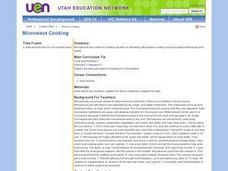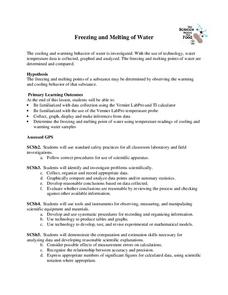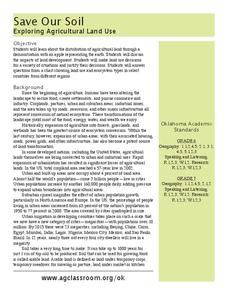Curated OER
Microwave Cooking
Students learn the basic principles of microwave cooking and prepare a dessert in the microwave using correct procedures.
Curated OER
Taste Buds
Students sample several sweet, sour, bitter and salty foods. They determine what part of their tongue tasted each flavor.
Curated OER
Why Walk?
Following the story Yummers, pupils will use the food pyramid to evaluate what Emily Pig ate during her walk and find out why her walk made her sick. They will then participate in a walking game.
Curated OER
Shark Island
Third graders are introduced to the game Shark Island and its rules. With a partner, they role play the role of either sharks or fish and try to get the shark's food and not get touched by the shark. They trade off roles with their...
Curated OER
A Fish in Water
Water is essential to all living things. This classroom experiment lets everyone observe goldfish and discuss what fish need to live, like food & clean water. They then listen to the book, Fish Out of Water, and compare the fictional...
Curated OER
Milk: A Practical Application
Students examine the impact of the physical and chemical properties of milk and its use as an important food.
University of Georgia
Endothermic and Exothermic Reactions
Equip your chemistry class with the tools to properly understand endothermic and exothermic reactions. Young chemists collect, analyze, and graph data to determine how the Law of Conservation of Matter is applied to chemical composition...
Curated OER
ADULT ESOL LESSON PLAN--Family and Parenting
Students, after reviewing a vocabulary list on the board, examine how to properly take care of children (requirement for food, shelter, hygiene, childcare providers, etc.). In addition, the legal side of taking care of children and their...
Curated OER
Microwave Introduction
Sixth graders learn the principles of microwave cooking and how to use and care for it properly while preparing foods.
Curated OER
Introduction to the Digestive System
Pupils describe the digestive system and simulate what happens to food as it passes through. They use an apple, tubing and hydrochloric acid to simulate the digestive process.
Curated OER
Learning Lesson: Measure the Pressure -- The "Wet" Barometer
Young scholars use simple objects to create their own barometer. They have five days to build it and ten days to observe and collect data. They examine thunderstorm safety tips to end the lesson.
University of Georgia
Antacid and Uncle Heartburn
Household materials can be used for more than cleaning! In this collaborative experiment, emerging chemists use products such as vinegar and liquid antacid to explore chemical reactions that commonly occur in the human body.
University of Georgia
Bag O' Isotopes
Accommodate your chemistry class with an experiment that is both entertaining and educational. Through the activity, blossoming chemists perform calculations on various isotopes, as represented by beans and legumes, to obtain the average...
University of Georgia
Freezing and Melting of Water
Examine the behavior of energy as water freezes and melts. An engaging activity provides a hands-on experience to learners. Collaborative groups collect data and analyze the graphs of the temperature of water as it freezes and then...
University of Georgia
Monohybrid Crosses and The Punnett Square Lesson Plan
Looking for a quick, hands-on activity to teach young scientists about Punnett squares through monohybrid crosses? then check out this one.
University of Georgia
Density and Texture of Soil
All soil is not created equal! A lab activity asks learners to collect and analyze soil. Specific calculations determine the amount of sand, silt, and clay in a sample and allow individuals to identify the soil texture.
Curated OER
Oh Nuts! - Calories Count
Students measure and record the mass of the nut to be tested to the nearest 0.01 gram.
Curated OER
Snowflake Bentley
Learners explore crystals through the story Snowflake Bentley and then create crystal pictures of their own. In this interdisciplinary lesson, they create a crystal web chart on chart paper, design artificial snowflakes, and write poems...
Curated OER
Organ Systems
Young scholars examine organisms that are composed of tissues, organs, and systems. They dissect a fetal pig and explore the assigned organs systems such as the skeletal, muscular, and circulatory organs. Students identify and explain...
Curated OER
Milk: A Practical Application
Explain the coagulation and coalescence processes associated with milk protein and cheese. List the components of milk and explain how each component is dispersed in the milk. Describe what happens when milk protein is coagulated Discuss...
Curated OER
Save Our Soil
Students read about the history of soil and complete language arts, math, social studies, and more activities about soil. In this soil lesson plan, students complete fraction problems, create a school compost pile, write about conserving...
Curated OER
Dibble Pond Ecosystem
Students collect specimen and analyze it. In this biology activity, students analyze and evaluate the diversity found in specific environment. They use the correct terminology as they do their write up for the experiment.
Curated OER
Independence and Conservation
Students read an original story "Brothers of the Rainforest" downloaded from the internet site provided. Students investigate the impact of the demise of a particular species on the rest of the environment. Students participate in a...
Curated OER
Chemical Changes Making Foam and Using Indicators
Students are able to observe chemcial and physical changes while producing a brilliant formation of foam. They are able to experience the use of an indicator in the reaction. Students record information based on their observations.

























